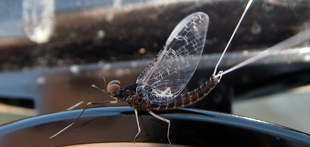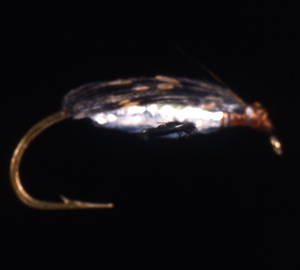|
|
|
Hatches - Waterboatmen and BackswimmersThe saying "It's raining like cats and dogs" usually puts things in perspective for the average angler. It brings up visions of being caught in a torrential downpour that often coincides with poor fishing conditions. However, there is another form of rain that knowledgeable anglers welcome and that is, the swarming or mating flights of waterboatmen or backswimmers. These air breathing insects, of the order Hemiptera, can provide some very exciting fishing action as they literally fall out of the sky. The classic waterboatmen/backswimmer "rain" or fall occurs on calm sunny days in early spring, late summer or early autumn. Raindrops just begin falling from the blue sky. The insects literally fly into the surface film and then attempt to swim to the lake or river bottom in an attempt to lay eggs. A waterboatmen or backswimmer fall is literally thousands of these winged insects hitting the surface of the water. Trout soon locate these dive bombers, many of which are momentarily stunned and struggle in the surface film. Slashing and boiling riseforms signal the attack on those insects while many more are picked off as they swim down to or up from the lake or river bottom. Before one knows it, the insect flight and fall is over, the surface of the water body again becomes quiet without any sign of an insect emergence having occurred.
Waterboatmen and Backswimmer Life History
Waterboatmen and backswimmers are common inhabitants of nutrient rich lakes and streams throughout North America and much of the rest of the world. There are no particularly distinct life stages or prolonged emergence sequences that catch the eye of the angler but trout can get extremely focused on them at very specific times of the season. For that reason it is very worthwhile understanding more about this basic trout food source.
Members of the insect order Hemiptera are known as true bugs and are differentiated from other insect orders by three key features:
There are also numerous members of this order that live aquatic life styles yet are still capable of flight. This includes over 100 species of waterboatmen and 30 species of backswimmers found in North American waters. These two insects are easily recognized by their distinct swimming action. Their hind pair of legs is elongated and feathered which allows them to move through the water in a pulsing or oar-like fashion.
Waterboatmen are the smaller of the two insects, with adults reaching lengths up to 3/8" inch long while adult backswimmers can reach more than ½ inch long. Besides their difference in size, the two insects can also be easily distinguished by the upside down swimming nature of the backswimmers and the fact that this larger insect can inflict quite a bite if handled. Breathing is accomplished by returning to the surface where air is stored in a plastron, a thin bubble of air covering the abdomen and under-surface of the hind pair of wings. This bubble of air appears as a mirror-like sheen as these insects swim through the water. Waterboatmen and backswimmers feed on a variety of food sources including smaller insects, crustaceans, snails and zooplankton. Some species of waterboatmen are strictly herbivorous in feeding.
Waterboatmen and backswimmers undergo an incomplete metamorphosis which includes egg, larval and adult stages. The life cycle typically consists of one generation per year. Larvae undergo 4-5 instars or molts before reaching the adult stage. The larvae are similar in appearance to the adult phase except they lack fully developed wings until the final instar is complete. Depending on the species, mating and deposition of eggs occur in the early spring or late fall. Eggs can be released in very shallow water to depths as much as 30 feet. Females dive to the bottom of the water body and attach eggs to woody debris, stems of plants or within the mud – water interface. Incubation time is generally less than a couple of weeks. Egg laying flights are one of the key times when trout focus on these insects simply because there are so many of them in the water. It also appears that numerous species of these insects will fly from one water body to another to establish new populations. These swarming or dispersion flights can occur at any time of the year but are most concentrated in the late summer to mid-fall period. These flights seem to be triggered by a combination of water and air temperature as they usually occur at higher elevations first. Outdoor swimming pool owners are very familiar with waterboatmen and backswimmer flights.
Common colouration of waterboatmen adults is a dark brown to black shellback (wing case) with an olive green to lemon yellow underside or abdomen. The plastron or air bubble is then overlaid on the surface of the abdomen. Backswimmers often have a mottled dark brown and tan shellback or wing case and an abdomen that usually displays a mottled pattern of several colours including yellow, tan and olive. The third or hind pair of legs is significantly longer than the remaining two pairs. Larval instars are generally lighter in all colours with the elongated hind legs still being prominent. As mentioned earlier, prime boatmen and backswimmer habitat includes nutrient rich lakes and slow moving rivers or streams. Productive water is key to providing the food and habitat required to sustain many aquatic invertebrates and the fish resources that prey on them.
Fly Fishing Tactics
Although trout prey on both larval and adult stages of these insects, it is the adult egg laying and dispersion flights that capture the most feeding attention. These insects are easily recognizable in the water and offer telltale signs of their arrival at the surface of the lake. Water chemistry conditions such as temperature and dissolved oxygen levels have less impact on these insects as they are air breathers. Their degree of activity is limited by the size of their air bubble. In lakes, it is not uncommon to catch trout on waterboatmen and backswimmer imitations at depths of 25 feet and more. A typical lake situation would see these insects diving into the water of all depth zones. Trout could be taking momentarily stunned adults in the surface film of water that is 5 or 55 feet deep. Summer stratification that occurs in many small productive stillwaters may prevent trout from feeding in water deeper than the thermocline because of potentially low oxygen levels but this situation would not affect the boatmen or backswimmers.
Surface feeding situations are easily recognized by the aggressive swirling riseforms evident in amongst the "rain drops". One can often track individual fish as they cruise just subsurface in search of another momentarily stunned victim. A floating line and suitable pattern is cast close to a foraging fish and an immediate quick short strip retrieve is initiated in hopes of attracting the attention of that or another nearby fish. Don't be afraid to chase after surface feeding fish over deep water as they are in the "looking up" mode.
Bright sunny days can sometimes deter fish from feeding at the surface and particularly when feeding in shallow water. One must therefore be prepared to fish patterns deeper in the water column. Subsurface fishing tactics can employ intermediate through extra fast sinking lines. An intermediate or slow sinking line can be quite effective when covering shallow water zones of stillwaters that are less than 10 feet in depth. Allow the fly line and fly to sink to just off the bottom and then impart the quick short (2-3 inches long) continuous strip retrieve. Five and ten feet fast sinking tip lines would cover slow moving river water situations. Again, the idea is to retrieve the waterboatmen or backswimmer pattern up through the water column. Deeper zones of the lake can be effectively covered with fast and extra fast sinking fly lines. Uniform or density compensated sinking lines can be cast out, allowed to sink towards the bottom, and then retrieved on varying angles up to the surface of the lake. The fly will be retrieved up through any prospective feeding zones.
Another effective strategy is to use regular sinking lines which sink in a shallow "U" shape. The heavier mid-section of the fly line sinks faster than the thinner tip section thus creating the uneven rate of descent. The tactic here is to cast out as far as possible, allow the line and belly to form and then begin the quick strip retrieve. The fly will then be pulled down and then back up through the water. Fish will take the fly on both the downward and upward retrieves.
Waterboatmen and backswimmers are fairly easy to imitate at the tying bench. Key features to consider are the general oval body shape, long pair of hind legs and the plastron of trapped air enveloping the underside of the abdomen. Sparkle Chenille, Flashabou, silver mylars and iridescent synthetic dubbings are just a few of the materials one can use to help give the illusion of the air bubble. Bead head Prince Nymphs and Zug Bugs will often fool fish during the early stages of a fall or dispersion flight but trout tend to get more selective after having eaten a few of the real bugs. It's always a good idea to check out the local fly shop for commercially tied imitations developed for area waters.
Waterboatmen and backswimmers don't get a lot of media attention perhaps because of their simple life cycle and that is probably just fine for the many trout and other species of fish that feed on them. However, there should be at least a few patterns of each tucked away in the fly box just in case the real insects begin raining on your favourite lake or river.
|
|
|
STILLWATER SEMINARS * GUIDING * HOSTED TRIPS
HATCHES:::Waterboatmen/Backswimmers
|
|
|||||
 |
|
 |
|||
|
|






